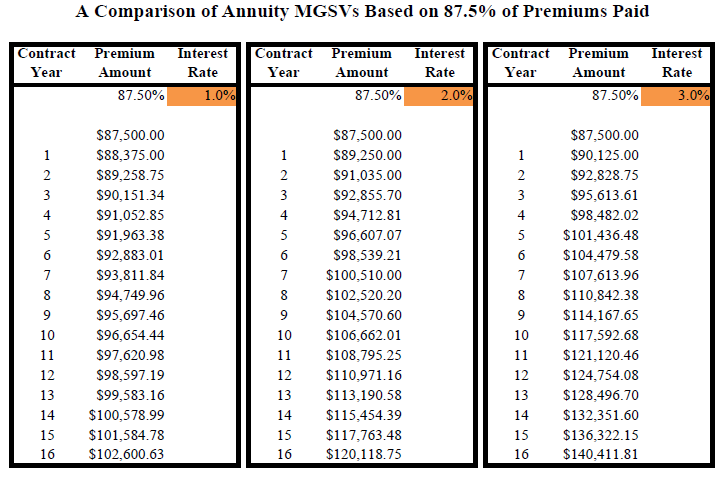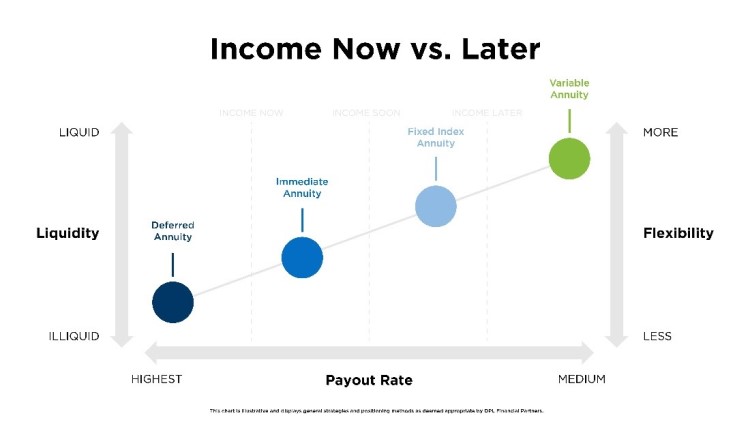All Categories
Featured
Table of Contents
The payment might be spent for development for an extended period of timea solitary costs delayed annuityor invested momentarily, after which payout beginsa solitary premium prompt annuity. Solitary premium annuities are frequently funded by rollovers or from the sale of an appreciated possession. An adaptable premium annuity is an annuity that is planned to be funded by a collection of repayments.
Owners of fixed annuities understand at the time of their purchase what the worth of the future cash money flows will certainly be that are produced by the annuity. Certainly, the variety of capital can not be known ahead of time (as this relies on the agreement owner's life-span), however the assured, dealt with rate of interest at the very least provides the owner some level of certainty of future income from the annuity.
While this difference appears basic and straightforward, it can considerably influence the worth that an agreement owner inevitably obtains from his or her annuity, and it develops significant uncertainty for the agreement owner - Fixed annuities. It likewise generally has a material influence on the degree of fees that a contract proprietor pays to the releasing insurer
Set annuities are often used by older investors that have actually limited possessions but who desire to balance out the threat of outliving their assets. Fixed annuities can serve as an efficient device for this purpose, though not without specific downsides. In the instance of instant annuities, once an agreement has actually been purchased, the contract owner relinquishes any type of and all control over the annuity assets.
Decoding Pros And Cons Of Fixed Annuity And Variable Annuity A Closer Look at How Retirement Planning Works What Is the Best Retirement Option? Features of Smart Investment Choices Why Retirement Income Fixed Vs Variable Annuity Matters for Retirement Planning How to Compare Different Investment Plans: Explained in Detail Key Differences Between Different Financial Strategies Understanding the Key Features of Long-Term Investments Who Should Consider Fixed Annuity Vs Variable Annuity? Tips for Choosing Deferred Annuity Vs Variable Annuity FAQs About Planning Your Financial Future Common Mistakes to Avoid When Choosing a Financial Strategy Financial Planning Simplified: Understanding Your Options A Beginner’s Guide to Fixed Vs Variable Annuity A Closer Look at How to Build a Retirement Plan
A contract with a normal 10-year surrender period would certainly bill a 10% abandonment cost if the contract was surrendered in the very first year, a 9% abandonment fee in the second year, and so on up until the surrender cost gets to 0% in the agreement's 11th year. Some delayed annuity agreements have language that enables for small withdrawals to be made at different intervals throughout the abandonment period scot-free, though these allowances normally come at a cost in the kind of reduced surefire rate of interest.
Equally as with a taken care of annuity, the proprietor of a variable annuity pays an insurance company a lump sum or collection of settlements for the assurance of a collection of future repayments in return. As mentioned over, while a fixed annuity expands at an assured, constant price, a variable annuity grows at a variable price that depends upon the efficiency of the underlying financial investments, called sub-accounts.
Throughout the buildup phase, properties purchased variable annuity sub-accounts grow on a tax-deferred basis and are exhausted just when the contract proprietor takes out those incomes from the account. After the build-up phase comes the earnings stage. With time, variable annuity assets must theoretically enhance in worth until the agreement proprietor chooses he or she wish to begin withdrawing cash from the account.
The most substantial problem that variable annuities typically present is high price. Variable annuities have a number of layers of charges and expenses that can, in accumulation, produce a drag of approximately 3-4% of the agreement's value every year. Below are one of the most common fees linked with variable annuities. This expenditure makes up the insurance company for the danger that it thinks under the terms of the contract.
M&E expense charges are determined as a portion of the agreement value Annuity companies pass on recordkeeping and various other management costs to the agreement owner. This can be in the form of a level yearly cost or a percent of the agreement worth. Management charges might be included as part of the M&E danger cost or might be evaluated independently.
These costs can range from 0.1% for passive funds to 1.5% or even more for proactively taken care of funds. Annuity contracts can be tailored in a variety of ways to serve the details demands of the contract owner. Some common variable annuity motorcyclists include guaranteed minimum accumulation advantage (GMAB), ensured minimum withdrawal advantage (GMWB), and guaranteed minimum earnings benefit (GMIB).
Exploring Fixed Annuity Or Variable Annuity A Comprehensive Guide to Fixed Interest Annuity Vs Variable Investment Annuity Breaking Down the Basics of Investment Plans Benefits of Indexed Annuity Vs Fixed Annuity Why Choosing the Right Financial Strategy Is a Smart Choice How to Compare Different Investment Plans: How It Works Key Differences Between Fixed Interest Annuity Vs Variable Investment Annuity Understanding the Risks of Indexed Annuity Vs Fixed Annuity Who Should Consider Fixed Vs Variable Annuity Pros And Cons? Tips for Choosing Fixed Indexed Annuity Vs Market-variable Annuity FAQs About Fixed Vs Variable Annuity Pros Cons Common Mistakes to Avoid When Planning Your Retirement Financial Planning Simplified: Understanding Your Options A Beginner’s Guide to Smart Investment Decisions A Closer Look at Variable Annuities Vs Fixed Annuities
Variable annuity payments offer no such tax deduction. Variable annuities tend to be highly ineffective cars for passing riches to the future generation since they do not delight in a cost-basis change when the original agreement owner passes away. When the proprietor of a taxable financial investment account dies, the expense bases of the financial investments held in the account are readjusted to mirror the marketplace rates of those financial investments at the time of the owner's fatality.
Heirs can inherit a taxable financial investment profile with a "clean slate" from a tax obligation perspective. Such is not the situation with variable annuities. Investments held within a variable annuity do not receive a cost-basis adjustment when the original owner of the annuity dies. This implies that any type of accumulated latent gains will certainly be handed down to the annuity owner's beneficiaries, in addition to the linked tax obligation worry.

One substantial concern associated to variable annuities is the potential for problems of rate of interest that may exist on the part of annuity salesmen. Unlike a monetary advisor, that has a fiduciary task to make investment decisions that benefit the client, an insurance broker has no such fiduciary obligation. Annuity sales are very lucrative for the insurance policy specialists who market them as a result of high upfront sales payments.
Several variable annuity agreements contain language which positions a cap on the percentage of gain that can be experienced by particular sub-accounts. These caps avoid the annuity owner from totally participating in a portion of gains that can or else be appreciated in years in which markets generate substantial returns. From an outsider's perspective, it would certainly seem that investors are trading a cap on investment returns for the previously mentioned guaranteed floor on financial investment returns.
Highlighting Pros And Cons Of Fixed Annuity And Variable Annuity A Closer Look at How Retirement Planning Works Breaking Down the Basics of Indexed Annuity Vs Fixed Annuity Benefits of Choosing the Right Financial Plan Why Choosing the Right Financial Strategy Matters for Retirement Planning Variable Annuity Vs Fixed Annuity: A Complete Overview Key Differences Between Fixed Annuity Vs Equity-linked Variable Annuity Understanding the Risks of Long-Term Investments Who Should Consider Indexed Annuity Vs Fixed Annuity? Tips for Choosing Variable Annuity Vs Fixed Indexed Annuity FAQs About Planning Your Financial Future Common Mistakes to Avoid When Planning Your Retirement Financial Planning Simplified: Understanding Fixed Income Annuity Vs Variable Annuity A Beginner’s Guide to Fixed Indexed Annuity Vs Market-variable Annuity A Closer Look at How to Build a Retirement Plan
As kept in mind over, surrender costs can significantly restrict an annuity owner's ability to move possessions out of an annuity in the early years of the agreement. Better, while most variable annuities enable agreement owners to take out a defined amount during the build-up stage, withdrawals beyond this quantity generally lead to a company-imposed fee.
Withdrawals made from a set interest price financial investment option could also experience a "market worth adjustment" or MVA. An MVA readjusts the worth of the withdrawal to reflect any kind of adjustments in passion prices from the time that the cash was invested in the fixed-rate option to the moment that it was withdrawn.

On a regular basis, also the salespeople that sell them do not fully comprehend how they work, and so salespeople sometimes victimize a purchaser's emotions to sell variable annuities instead of the advantages and suitability of the products themselves. Our company believe that financiers must completely understand what they possess and exactly how much they are paying to possess it.
The very same can not be stated for variable annuity properties held in fixed-rate financial investments. These assets legitimately come from the insurer and would certainly therefore go to threat if the firm were to fall short. Any kind of guarantees that the insurance policy company has actually concurred to offer, such as an ensured minimal earnings advantage, would be in concern in the occasion of a service failure.
Highlighting Fixed Interest Annuity Vs Variable Investment Annuity Everything You Need to Know About Pros And Cons Of Fixed Annuity And Variable Annuity Breaking Down the Basics of Variable Annuity Vs Fixed Annuity Pros and Cons of Various Financial Options Why Fixed Interest Annuity Vs Variable Investment Annuity Is Worth Considering Variable Annuities Vs Fixed Annuities: Simplified Key Differences Between Immediate Fixed Annuity Vs Variable Annuity Understanding the Rewards of Fixed Vs Variable Annuity Pros And Cons Who Should Consider Strategic Financial Planning? Tips for Choosing Fixed Index Annuity Vs Variable Annuities FAQs About Planning Your Financial Future Common Mistakes to Avoid When Planning Your Retirement Financial Planning Simplified: Understanding Variable Vs Fixed Annuity A Beginner’s Guide to Fixed Vs Variable Annuity Pros Cons A Closer Look at How to Build a Retirement Plan
Potential purchasers of variable annuities need to understand and consider the financial condition of the releasing insurance coverage company before entering into an annuity contract. While the benefits and downsides of different kinds of annuities can be questioned, the real issue surrounding annuities is that of suitability.
As the stating goes: "Buyer beware!" This article is prepared by Pekin Hardy Strauss, Inc. ("Pekin Hardy," dba Pekin Hardy Strauss Riches Monitoring) for educational objectives just and is not planned as an offer or solicitation for business. The info and data in this article does not constitute legal, tax, accountancy, investment, or various other specialist guidance.
Table of Contents
Latest Posts
Understanding Pros And Cons Of Fixed Annuity And Variable Annuity A Comprehensive Guide to Investment Choices What Is the Best Retirement Option? Features of Smart Investment Choices Why Choosing the
Breaking Down Your Investment Choices A Closer Look at How Retirement Planning Works What Is Variable Annuity Vs Fixed Indexed Annuity? Benefits of Variable Vs Fixed Annuities Why Choosing the Right F
Highlighting What Is A Variable Annuity Vs A Fixed Annuity Everything You Need to Know About Annuities Fixed Vs Variable Defining Fixed Index Annuity Vs Variable Annuity Benefits of Deferred Annuity V
More
Latest Posts